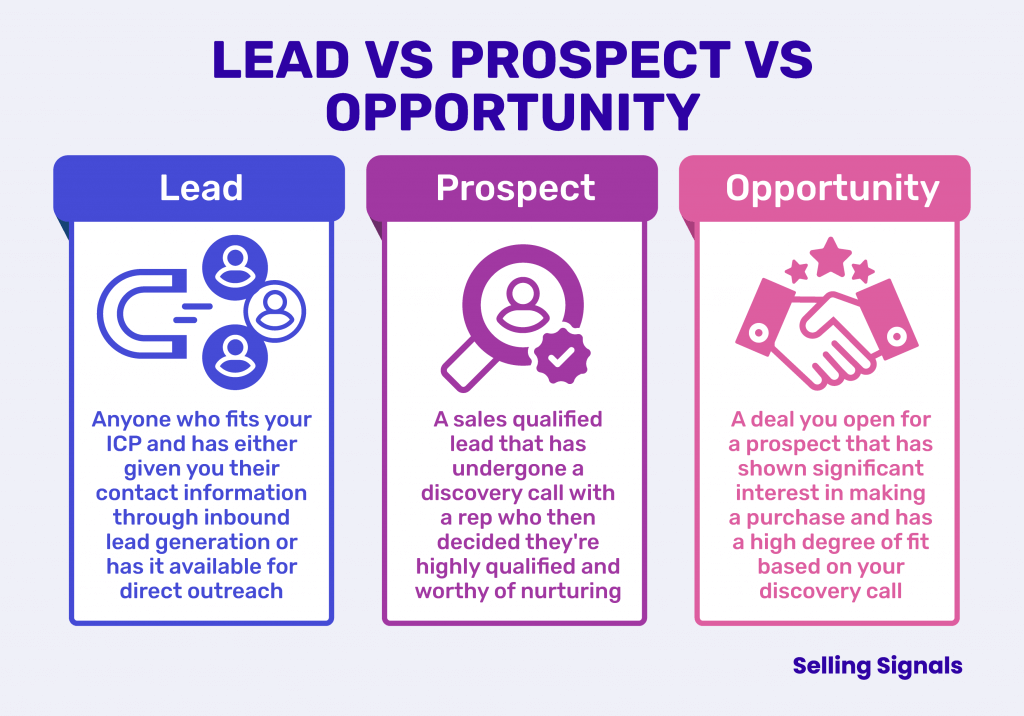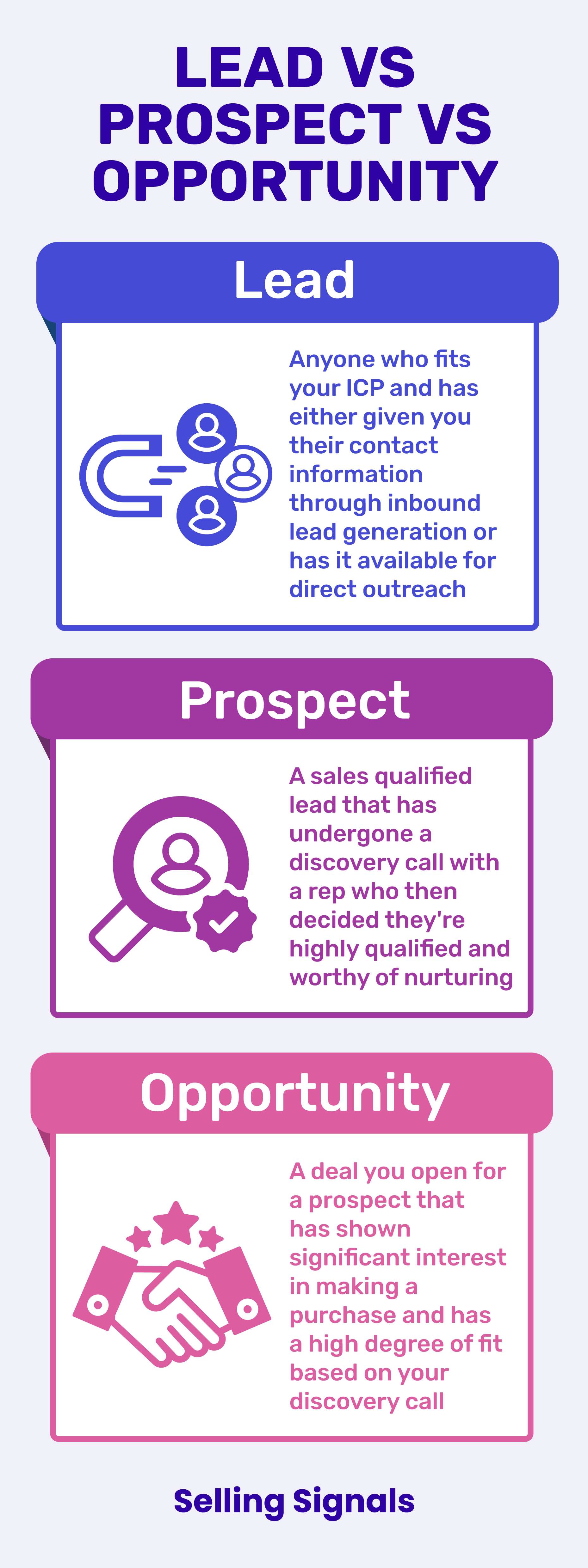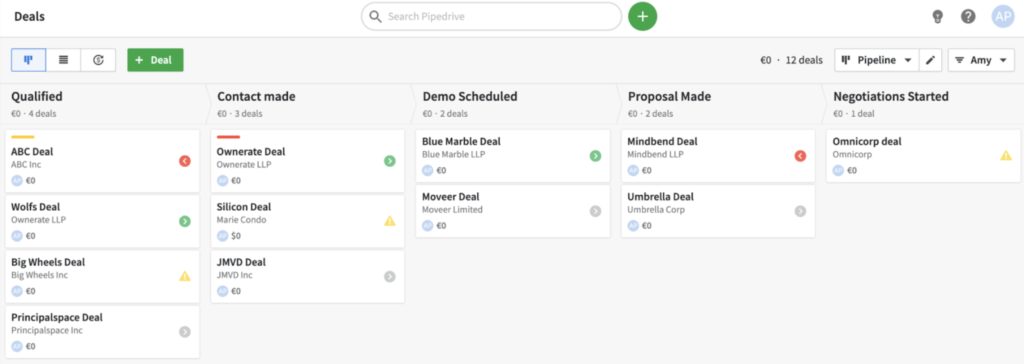-
News & Trends -
Sales -
Marketing Related Topics -
B2B Software Guides Related Topics -
Free Tools & Resources -
- About Us About Us
A lead is a person or organization that fits your ideal customer profile and could eventually purchase your product or service. Once you contact and qualify them as a fit, they become a prospect; you then open an opportunity for them, which is the deal you'll move through your sales pipeline to close. Understanding where your potential customers sit in your pipeline helps you to make informed decisions that’ll get them into a buyer mindset.


A lead enters your pipeline in the lead generation step of your sales process. They represent anybody who fits your ideal customer profile (ICP) but has had little to no direct contact with your business. The lead becomes a prospect when you qualify them for fit and interest in your product or service — in other words, when they’ve shown that they're “sellable."
For example, if a lead responds to your email to request more information or takes another action that signifies buy intent, and they also give promising answers during a needs assessment and discovery call, you can now mark them as a prospect. As a lead becomes a prospect, they also move from the lead generation stage into the lead qualification stage.
A lead is anybody who fits your ICP and has either given you their contact information through inbound lead generation, or has it publicly available for direct outreach. However, there are typically multiple types of leads that help you segment your sales pipeline to follow up with the most important contacts. To make the most out of each lead, it’s important to know which type of lead they are.
Below, we'll define a marketing lead (aka a marketing qualified lead, or MQL), a sales lead (including both a sales assisted lead, or SAL, and a sales qualified lead, or SQL), a cold lead, and a bad lead.
Leads generated by marketing go through each stage — MQL, SAL, and SQL — while those generated directly by a salesperson skip the first stage and are immediately a sales lead.
A prospect is an SQL that has undergone a discovery call with a salesperson, who has decided they're highly qualified and worthy of nurturing. If a prospect first goes through both the MQL and SAL levels, the seller will likely have a good amount of background details on them, but the discovery call is the best way to learn as much relevant information as possible. This information will help the seller nurture the prospect and try to close the deal.
We’ve outlined the basics of handling certain leads and prospects, but now is the time to take you step-by-step through the process of converting a lead into a prospect. The steps include scoring the lead, conducting a needs assessment, following up, and hosting a discovery call. These steps are specific enough to determine what your goal is with each contact, but broad enough to ensure that you can customize them to fit your industry. Let’s take a closer look at each.
One of the ways to improve your conversion is to score your inbound leads. The marketing team conducts lead scoring by giving each lead a point-based score that takes into account how likely they are to make a purchase. The factors they consider typically include demographic/company details, engagement with your company, and online behavior.
These are the sequential steps to score your leads:
Lead scoring is the responsibility of the marketing team, but it's a good idea for marketing and sales to work together to create and refine it. For example, if sales finds that they're receiving poor fits, communicate this to marketing so the MQLs they pass along can be better fits in the future.
For more information on lead scoring and the steps to set up your scoring system, check out our guide on lead scoring. In it, we lay out the entire process and offer some helpful examples.
The goal with your initial contact is simple: qualify your lead’s interest and ability to purchase your solution. This can be done over an online or live needs assessment. When you set up the needs assessment, ask some basic qualification questions. You can include as many as you’d like, but remember to frontload the important ones to keep your lead on the phone or encourage them to finish the written assessment.
Consider asking questions like these on a needs assessment:
Each of these serves its own purpose, and they help inform the rest of the process. Asking all of them will get you all of the necessary information to mark a lead as an SAL. You'll know how they heard about you and which goals they're trying to accomplish, or pain points they're trying to solve, plus what they like about your solution. You’ll also get an idea of a timeline of when they’d like to buy and any other additional details you request.
For the step-by-step process to create a web form, online questionnaire, or live needs assessment, read our article on how to conduct a needs assessment. In the article, you'll also find examples of effective assessments.
Now that you have an SAL, set defined dates for discussing the sale further. At the end of your qualification quiz or call, always offer a range of dates and times for a follow-up appointment, or tell them a salesperson will get in touch with them.
Here are a couple ways to initiate a follow-up:
If the lead doesn’t agree to a set follow-up appointment time, be sure to follow up proactively. This process can differ between industries, but generally, you’ll be calling the lead and sending an email at least every other day. Typically, you’ll do both in tandem, and stop after 3–5 attempts.
Have a 20- to 30-minute discovery call with each SAL to ensure they're qualified enough to nurture. On the call, ask questions about key details such as their budget, decision-making power, needs, and timeline for a purchase.
These are the specific steps to follow in order when holding a discovery call:
If you qualify them as an SQL on the discovery call, immediately mark that status change in your sales CRM and move the lead into your lead nurturing stage of your sales process.
For more on the steps to hold a successful qualification call, check out our article on discovery calls. There, you'll learn what they are, how to conduct them, and which questions to ask, as well as a script you can follow.
A prospect is an SQL that you've qualified via a discovery call. They've now left the lead generation stage and entered the lead nurturing stage. At this point, you open a sales opportunity for them in your sales pipeline; this is the deal you'll try to close. Creating this opportunity will help you focus on the potential customers that are most likely to convert.
A sales opportunity is a deal you open for a prospect that has shown significant interest in making a purchase and has a high degree of fit based on your discovery call. Opportunities are associated with your highest priority prospects — those who indicate the best odds of converting. Since their level of interest is highest, nearly every piece of correspondence will come with an offer to close at this point — you now have ample reason to reach out more often with an offer.
Translating a prospect into an opportunity simply means opening an opportunity for qualified prospects. If you use sales pipeline software or a CRM, you'll have created a record for the lead before this point; to open an opportunity, you'll add the new info you've learned to the record and move it to the first stage of your pipeline's lead nurturing step. Then, you'll use that new info to help you close the deal.
Here's an example of a Pipedrive sales pipeline that lists stages from qualification to negotiations. The salesperson who owns the opportunity would move the deal through each stage by nurturing the prospect:

Once you open an opportunity, start discussing the deal size, terms, and other specifics so you can sell your product or service as a solution to the needs you've learned they have. Treat these prospects as a top priority, since they're likely to purchase your product or service.
While the terms "lead," "prospect," and "opportunity" are sometimes used interchangeably, we hope this article makes clear how and why you should differentiate them. Each term should invoke a different response and represent a different part of your sales process. Now that you can properly identify leads, prospects, and opportunities, read our article on creating a sales pipeline to organize your lead generation, qualification, and nurturing efforts even more.
This article was written by Trey LaRocca and updated by Allyssa Haygood-Taylor.
Trey is a former salesperson and current Orange County-based tech, sales, and finance writer. His specialties include sales guides, personal finance articles, and reviews across financial and credit products. In his free time, Trey writes fiction and practices boxing and Brazilian jiu-jitsu.

Selling Signals delivers actionable advice for sales and marketing professionals. Learn strategies that help you hit targets, strengthen customer relationships, and win more business. Get expert advice on lead generation, sales processes, CRM software, sales management, and account management directly to your inbox.
Property of TechnologyAdvice. © 2025 TechnologyAdvice. All Rights Reserved
Advertiser Disclosure: Some of the products that appear on this site are from companies from which TechnologyAdvice receives compensation. This compensation may impact how and where products appear on this site including, for example, the order in which they appear. TechnologyAdvice does not include all companies or all types of products available in the marketplace.